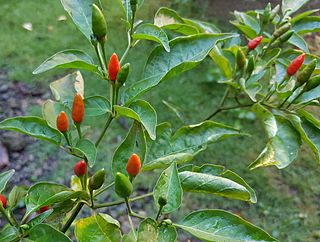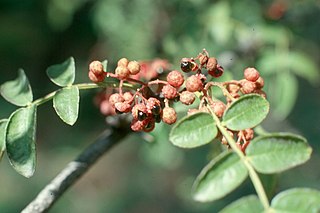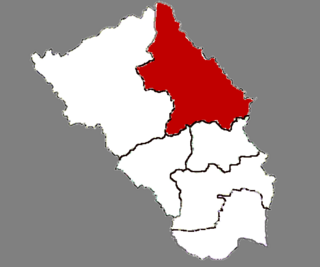
The Rutaceae is a family, commonly known as the rue or citrus family, of flowering plants, usually placed in the order Sapindales.

Zanthoxylum is a genus of about 250 species of deciduous and evergreen trees, shrubs and climbers in the family Rutaceae that are native to warm temperate and subtropical areas worldwide. It is the type genus of the tribe Zanthoxyleae in the subfamily Rutoideae. Several of the species have yellow heartwood, to which their generic name alludes. Several species are cultivated for their use as spices, notably including Sichuan pepper.

Siling labuyo is a small chili pepper cultivar that developed in the Philippines after the Columbian Exchange. It belongs to the species Capsicum frutescens and is characterized by triangular fruits that grow pointing upwards. The fruits and leaves are used in traditional Philippine cuisine. The fruit is pungent, ranking at 80,000 to 100,000 heat units in the Scoville Scale.

"Uzazi" is the Nigerian name for the 'prickly ash' tree of genus Zanthoxylum tessmannii / Fagara tessmannii / Zanthoxylum gilletii, a member of the Rutaceae family, native to Central and West Africa, and a close relative of the Sichuan pepper. It usually refers specifically to the spice made from its fruit and pericarp, though sometimes other parts of it such as its leaves are used.

Zanthoxylum fagara or wild lime, is a species of flowering plant that—despite its name—is not part of the genus Citrus with real limes and other fruit, but is a close cousin in the larger citrus family, Rutaceae. It is more closely related to Sichuan pepper. It is native to southern Florida and Texas in the United States, and to Mexico, Central America, the Caribbean, and South America as far south as Paraguay. Common names include: lime prickly-ash, wild lime, colima, uña de gato, and corriosa.

Zanthoxylum americanum, the common prickly-ash, common pricklyash, common prickly ash or northern prickly-ash, is an aromatic shrub or small tree native to central and eastern portions of the United States and Canada. It is the northernmost New World species in the citrus family, Rutaceae, and is the type species in its genus, which includes sichuan pepper. It can grow to 10 meters (33 ft) tall with a diameter at breast height (DBH) of 15 cm (5.9 in). It produces membranous leaflets and axillary flower clusters. The wood is not commercially valuable, but oil extracts from the bark have been used in traditional and alternative medicine, and have been studied for antifungal and cytotoxic properties. The genus name is sometimes spelled Xanthoxylum.

Shanting is a district of the city of Zaozhuang, Shandong province, China.

Zanthoxylum asiaticum is a species of plant in the family Rutaceae. Under its synonym Toddalia asiatica, it was the only species in the monotypic genus Toddalia, now included in Zanthoxylum. It is known by the English name orange climber.

Zanthoxylum armatum, also called winged prickly ash or rattan pepper in English, is a species of plant in the family Rutaceae. It is an aromatic, deciduous, spiny shrub growing to 3.5 metres (11 ft) in height, endemic from Pakistan across to Southeast Asia and up to Korea and Japan. It is one of the sources of the spice Sichuan pepper, and also used in folk medicine, essential oil production and as an ornamental garden plant.

Zanthoxylum piperitum, also known as Japanese pepper or Japanese prickly-ash, is a deciduous aromatic spiny shrub or small tree of the citrus and rue family Rutaceae, native to Japan and Korea.

Zanthoxylum acanthopodium, or andaliman, is a species of flowering plant in the family Rutaceae. Its range includes southern western China, Bangladesh, Bhutan, northern India and northeastern India, Nepal, Laos, Burma, northern Thailand, Vietnam, Indonesia, and Peninsular Malaysia.

Zanthoxylum schinifolium, also called mastic-leaf prickly ash, is a species of flowering plant in the Rutaceae, the citrus family.

Sichuan pepper (Chinese: 花椒; pinyin: huājiāo, also known as Sichuanese pepper, Szechuan pepper, Chinese prickly ash, Chinese pepper, Mountain pepper, and mala pepper, is a spice commonly used in Sichuan cuisine in China, and in northeast India. It is called mejenga in Assam, India. In Nepal, Timur or Timut pepper is a commonly used spice and is often confused with Sichuan pepper because they look similar and both share some characteristics. Despite its name, Sichuan pepper is not closely related to black pepper or chili peppers. It is made from plants of the genus Zanthoxylum in the family Rutaceae, which includes citrus and rue.

Zanthoxylum rhetsa, commonly known as Indian prickly ash, is a species of flowering plant in the family Rutaceae and occurs from India east to the Philippines and south to northern Australia. It is a deciduous shrub or tree with cone-shaped spines on the stems, pinnate leaves with between nine and twenty-three leaflets, panicles of white or yellowish, male and female flowers, followed by spherical red, brown or black follicles.
Zanthoxylum echinocarpum is a woody plant in the family Rutaceae and is native to South-Central and Southeast China.
Zanthoxylum esquirolii is a woody plant in the family Rutaceae from Guizhou, Sichuan, and Yunnan China.
Zanthoxylum molle is a woody plant from the Rutaceae family.
Zanthoxylum dimorphophyllum is a tree from the family Rutaceae.
Zanthoxylum pilosulum is a woody plant from the Rutaceae family native to western and northwestern Sichuan and southern Shaanxi and Gansu provinces, China.














